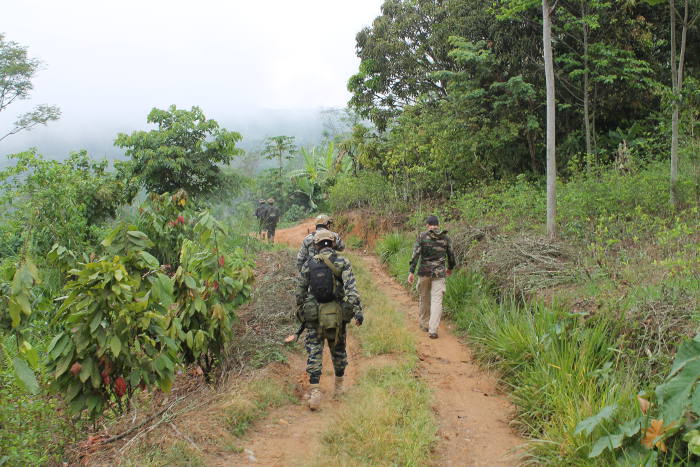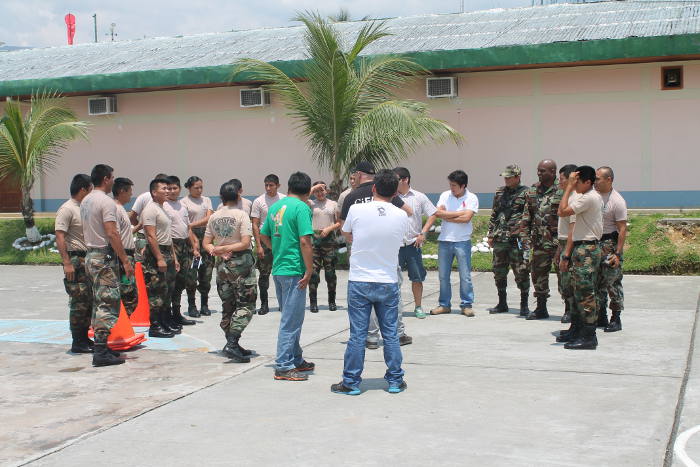-
24 June 2016
Category : Opinion
Training for fighting drug trafficking on the front lines
Gerard Muñoz, is the coordinator of the project to fight drug trafficking in Peru. In this post, he talks about his experience in a training course on basic investigative techniques held in the Peruvian jungle.

It’s still several hours before sun-up and the jeep being driven by an officer in the anti-narcotics directorate is weaving around the sinuous, hairpin curves of a goat trail that will take us from Ayacucho to a government base in the middle of the jungle, near the valley of the Apurímac, Ene and Mantaro rivers, a territory located northeast of the capital of the Huamanga region.
The landscape is hard, like the people’s faces and characters; it’s a mountain range that gives way to dense and inaccessible jungle as the hours and kilometres go by. Ayacucho, the city we are leaving behind, is where the internal Peruvian conflict began that between 1980 and 2000 left 70,000 dead or missing. The victims included farmers, mayors, leaders and militants of political organisations, teachers, engineers, priests and nuns, labours, journalists, housewives, police officers and members of the armed forces.
Here no one has forgotten. To understand the situation facing us, you simply have to walk through the zone and listen to people tell you how their families were brutally tortured or murdered. It doesn’t take us long to realise that the State is not exactly welcome in these parts.
In Peru, an arroba (11 kg) of coca leaf sells for $45. Each hectare under cultivation can bring a cocalero up to $10,000 per year. Each 265 kg of coca leaf can yield 1 kg of cocaine chlorhydrate (what people sniff), with a total production cost of around $1,200 in Peru. This same kilo of cocaine is sold by the ‘narco’ in Spain for €36,000; from there, the local dealer cuts it however he chooses and sells it for €60 a gram. Peruvian coca leaf is especially efficient because of its high concentration of alkaloids; for the narco, Peru is a paradise for cultivating coca.
In the coca production zones, there is no transportation infrastructure, no hospitals or clinics, hardly any schools, and, of course, forget about universities or even basic services like drinking water or sewer systems. Many citizens feel abandoned by institutions, and it is the narco who sets the rules.
It’s enough to see the harsh reality of many of the inhabitants of these coca-producing regions to get an idea of what needs to be addressed. According to data from the Ministry of Development and Social Inclusion, nominal poverty may affect as much as 60% of the population, and up to 30% of children suffer from malnutrition.

The group of police officers in formation. In territories like this one, beyond the reach of the State and with no strong institutions, crime is endemic and it’s a question of survival of the fittest.
After a 10-hour hike, we reach the base, which is a military compound in the middle of the jungle surrounded by a wall topped with barbed wire. The commander, the perfect host, welcomes us and provides us with all the comforts a facility like this has to offer.
The daily routine during the training course is to get up at 5:00 a.m., exercise, eat breakfast, and then start classes at 8:00. The training is on basic investigative techniques and includes a real operation to raid paste pits for coca leaves and a laboratory. There is a 50-minute break for lunch, and at 5:00 p.m. classes are over. At the base, there is nothing to do except jog on the runway off to one side of the facility or go to the gym. Dinner is at 7:00 p.m., and bedtime is 9:30 p.m. My electronic book turns out to be perfect for these occasions.
These types of training courses make a difference. This is the first time the students, normally very young officers who have been posted to a hostile territory, are learning, first-hand, techniques, adapted to their reality, which will improve operational efficiency exponentially. This is vitally important in terms of the handling of evidence to ensure that it is admissable in a trial.
On this occasion, in addition to a theoretical module, the students and instructors took part in a real raid on a laboratory involving an on-the-spot investigation that could lead to the arrest of a narco, or at least satisfactory collection of evidence that can be used against the individual later. Prosecutors also participated in the training course and the operation, providing a more complete vision of all the players in the criminal process.
Now, when the men start trusting you and you spend 24 hours a day with people like this on the front lines of the fight against drugs in the jungle, reality speaks for itself. The problem of drug trafficking is very broad and, although the work done at times like this is vital for preventing traffickers from infiltrating some countries’ institutions, more than they already have, a comprehensive, long-term strategy is needed. This would require courageous decisions at the international level, such as doing away with tax havens, among other measures with high political impact.
Gerard Muñoz, is the coordinator of the project to fight drug trafficking in Peru.
The views and opinions expressed in this blog are the sole responsibility of the person who write them.




